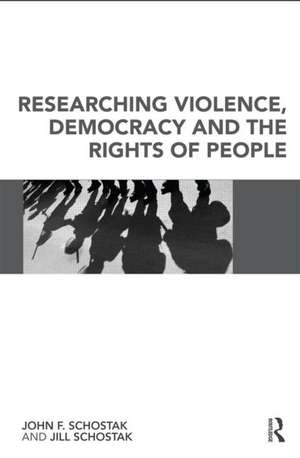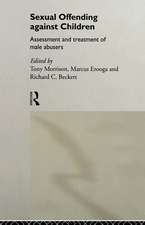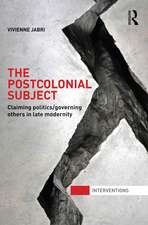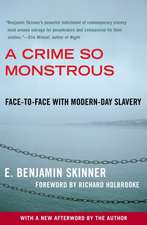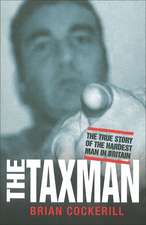Researching Violence, Democracy and the Rights of People
Editat de John Schostak, Jill Schostaken Limba Engleză Paperback – 25 noi 2009
Research is fundamentally entwined with the political, the ethical and the legal. When it presumes the neutrality of method and ignores its radical roots of inquiry, it is in danger of being politically co-opted and ethically naïve. Research that reveals what is at stake politically, ethically and legally is typically open to accusations of being partisan and therefore political. It cannot avoid being political in the broadest sense of the word, and consequently the researcher cannot escape – through some mystical notion of being ‘objective’ – the political, ethical and legal consequences of undertaking research.
Research is vital to the construction of public spaces for debate, decision making and action. Hence, there is a close relationship between methodological practices, research design and the conditions under which violence, democracy and rights can be addressed.
Researching Violence, Democracy and the Rights of People explores what is at stake methodologically (both theoretically and practically) for researchers seeking to expand opportunities for people to become visible upon the public stages of debate, decision making and action, and thus make audible their experiences of wrongs and injustices, express their rights, and engage democratically in processes of change.
Drawing on international contributions and contexts, this book introduces readers to the complex realities of real research and the substantive issues that their methodological approaches strive to deal with. It will benefit undergraduate and postgraduate students as well as post-doctoral and experienced researchers across a range of cultural and social science disciplines, as well as educational and sociological researchers. Its aim is to explore and contribute to the development of innovatory approaches to engaging in research that make a difference in the lives of people.
| Toate formatele și edițiile | Preț | Express |
|---|---|---|
| Paperback (1) | 401.70 lei 6-8 săpt. | |
| Taylor & Francis – 25 noi 2009 | 401.70 lei 6-8 săpt. | |
| Hardback (1) | 1057.89 lei 6-8 săpt. | |
| Taylor & Francis – 25 noi 2009 | 1057.89 lei 6-8 săpt. |
Preț: 401.70 lei
Nou
Puncte Express: 603
Preț estimativ în valută:
76.87€ • 82.20$ • 64.09£
76.87€ • 82.20$ • 64.09£
Carte tipărită la comandă
Livrare economică 17 aprilie-01 mai
Preluare comenzi: 021 569.72.76
Specificații
ISBN-13: 9780415478786
ISBN-10: 0415478782
Pagini: 268
Dimensiuni: 156 x 234 x 15 mm
Greutate: 0.43 kg
Ediția:1
Editura: Taylor & Francis
Colecția Routledge
Locul publicării:Oxford, United Kingdom
ISBN-10: 0415478782
Pagini: 268
Dimensiuni: 156 x 234 x 15 mm
Greutate: 0.43 kg
Ediția:1
Editura: Taylor & Francis
Colecția Routledge
Locul publicării:Oxford, United Kingdom
Public țintă
Postgraduate, Professional, and UndergraduateCuprins
@contents: Selected Contents: Introduction Part A: Design, Values, Violence and Rights 1. Values, Violence, Rights Part B: Research Accounts Introduction to Part B 2. Rethinking justice in education and training 3. Between justice and pathologisation: juxtapositions of epistemic and material violence in transnational research around migration and domestic violence. METHODOLOGICAL DISCUSSION SECTION i: on values, justice, knowledge .and identity 4. The scarf unveiled: proximity to the test of law in a French school 5. Social Research and ‘Race’: Developing a critical paradigm 6. Violence, Social Exclusion and Construction of Identities in Early Childhood Education Concepción Sánchez Blanco METHODOLOGICAL DISCUSSION SECTION ii: resisting identities and boundaries 7. The construction of Violence/non-violence by schools and the media 8. Charlie Why Ya Hideing: The Role of Myth and Emotions in the Lives of Young People Living in a High Crime Area 9. Passionate Places and Fragmented Spaces 10. The Return of the Repressed METHODOLOGICAL DISCUSSION SECTION iii: places, visible, invisible and their ‘dis/contents’ 11. Discursive and Material forms of Violence in the US in a post 9/11 Era 12. Militarizing Higher Education: Resisting the Pedagogy of Violence METHODOLOGICAL DISCUSSION SECTION iv: The language of critical resistance, emancipatory practices and the construction of the conditions for action and the containment of change Part C: Framing the Design and Writing Up 14. Writing for Emancipatory Research Conclusion
Notă biografică
John F. Schostak is Research Professor of Education at the Education and Social Research Institute, Manchester Metropolitan University.
Jill Schostak is Visiting Fellow at the School of Education and Lifelong Learning, University of East Anglia, and most recently has undertaken contract research with the College of Emergency Medicine.
Jill Schostak is Visiting Fellow at the School of Education and Lifelong Learning, University of East Anglia, and most recently has undertaken contract research with the College of Emergency Medicine.
Recenzii
"The book provides a useful comparative approach to the issue of violence and the democratic rights of people. In addressing the question - Is there a real need for a book? This could be answered at a number of levels. There is definitely a scholarly need for a book on this issue and I think more relevantly there is a democratic need for such a book. Clearly the problems of violence and democratic rights cover all of the major continents of the world but this particular book would sell most vigorously in the UK and Europe with some side orders to the US. If Routledge has an active agency in Europe there could be some decent mainland sales. What I like about the book is its comparative approach and its considerable conceptual grasp. These are fairly practised editors and I suspect they would do a fairly good job in synthesising the disparate elements which are endemic to any edited book. The authors are recognised authorities in this field and have written before on issues of youth, violence and issues of civic democracy. They also have a very good grasp of research methodology which will be helpful in weaving synoptically together the disparate themes.
In summary I like the book very much. I think that it has considerable scholarly and civic potential and should be published."
Prof Ivor Goodson, University of Brighton
"Is there a real need for this book and what are the principal markets? Please indicate the level at which the book would appeal and identify the main buyers
Given the contemporary orientation to a rights perspective and preoccupations with violence there is a prima facie case for saying, 'yes'. Given that the 'rights' agenda is mostly focused on global and development scenarios, however, this limits the potential market for the book. It remains, I'd have thought, pretty firmly rooted in the traditional area of doctoral students in sociology and related disciplines and their supervisors. John Schostak's previous books will, no doubt, provide the most accurate guide as to potential sales. Three US authors (especially Giroux and, I guess, Wacquant) and a chapter dealing with 9/11 will help US sales - but my impression is that this is not mainstream even for US academics. Translation into French would seem to be a good bet.
4. What are the principal competitive books available and what particular advantages have the proposed new book?
I'm not sure. The editors say there are none. I suspect they mean none within the sociological discourse they are elaborating here. Below I refer to other discourses which sound related - but possibly are not.
"
1. Need and Principal Market
There is no doubt that ‘violence’ is an increasingly important inter-disciplinary topic. Globalization and 24/7 media coverage has increased the visibility of violence. The societal capacity for violence has arguably never been greater and the need to understand violence perhaps never more urgent. The extent to which this will translate in to demand for academic texts is, of course, difficult to judge. The editors are thinking in terms of an edited collection that appeals to both undergraduate and postgraduate students and I think this is about right. However, their slant on the topic towards methodological issues may well suggest that it is a text for 3rd year undergraduate and postgraduate students. I see no reason why, if properly marketed, it should not sell in North America and Australia; although in my experience USA academics can be remarkably parochial. Perhaps the important thing to note about the book is that it could, if written with this in mind, appeal to a wide range of disciplines and fields of social action: Sociology, Social Work, Criminology, Politics, Cultural Theory, Development Studies and Education, for example.
2. The Student Market
As I have noted I think this is probably a text for third year undergraduate students, MA students and research degree students. I would be surprised if it was widely used as a set course text, rather I would expect to find it on recommended reading and certainly in the library.
3. Price
I would have thought around £20.
4. Competitors and Competitive Advantage
I am not aware of a book that covers the same ground as the proposed edited collection. Typical texts on violence are usually about the sites and forms of violence, violent events, violent regimes, cultures of violence and individual violent pathologies. This book claims to explore ‘methodologies as a form of violence’ and this alone makes it unusual. It is also clearly looking at violence in the context of what one might call ‘emancipatory projects’ of one kind or another and this too sets it apart from many texts on the topic.
The work of Jenny Pearce at the Institute of Development Studies (Sussex) on Violence Power and Participation might well touch on similar themes. Her work explores enhancing participation in civil society in the context of chronic violence. There is a book published by Routledge edited by Barbara Fawcett and Fran Waugh (2007) Addressing Violence, Abuse and Oppression, which provides an overview of violence in relation to a range of groups and areas that involve people working in human service contexts. It is concerned with issues of gender, poverty, class, race and sexuality. But I don’t see these as competitors for the Schostak and Schostak collection, although it would help if they were aware of them.
5. How quickly is this book likely to become out of date?
Good question and I’m not entirely sure I could judge without reading the book in some detail. My guess is that given its themes and the focus on methodology it will not become dated rapidly. I would give it a longish shelf life.
6. The Authors
John Schostak is a well recognised, respected and talented writer. His books on methodology are amongst the best published in the last ten years.
7. Coverage
The collection is varied and stimulating. The chapters look as if they will make interesting cases and the task for the editors is to tell a coherent story that threads them together and gives them some thematic unity. It is culturally diverse, which is a good thing. I think the coverage is fine and if the chapters turn out to be as interesting as they sound the book could make an excellent teaching resource for imaginative teachers.
8. Do you recommend that we should publish the book?
Yes I do. I think it will be a good edited collection. "
Professor Nigel Norris
Centre for Applied Research in Education University of East Anglia Norwich
In summary I like the book very much. I think that it has considerable scholarly and civic potential and should be published."
Prof Ivor Goodson, University of Brighton
"Is there a real need for this book and what are the principal markets? Please indicate the level at which the book would appeal and identify the main buyers
Given the contemporary orientation to a rights perspective and preoccupations with violence there is a prima facie case for saying, 'yes'. Given that the 'rights' agenda is mostly focused on global and development scenarios, however, this limits the potential market for the book. It remains, I'd have thought, pretty firmly rooted in the traditional area of doctoral students in sociology and related disciplines and their supervisors. John Schostak's previous books will, no doubt, provide the most accurate guide as to potential sales. Three US authors (especially Giroux and, I guess, Wacquant) and a chapter dealing with 9/11 will help US sales - but my impression is that this is not mainstream even for US academics. Translation into French would seem to be a good bet.
- If the book is intended for the student market, how would you expect it to be used (e.g. indicate whether main text, recommended reading, library only). Please list courses:
- What would you consider to be a reasonable price for the book?
4. What are the principal competitive books available and what particular advantages have the proposed new book?
I'm not sure. The editors say there are none. I suspect they mean none within the sociological discourse they are elaborating here. Below I refer to other discourses which sound related - but possibly are not.
- How quickly is this book likely to become out of date?
- Is the author a recognised authority in this field?
John Schostak is, yes, a good authority on social theory, methodology, rights, etc. One would have a great deal of confidence in him to produce a work of merit in relation to sociological method.
- Do you recommend that we should publish this book?
Yes, certainly. "
"
1. Need and Principal Market
There is no doubt that ‘violence’ is an increasingly important inter-disciplinary topic. Globalization and 24/7 media coverage has increased the visibility of violence. The societal capacity for violence has arguably never been greater and the need to understand violence perhaps never more urgent. The extent to which this will translate in to demand for academic texts is, of course, difficult to judge. The editors are thinking in terms of an edited collection that appeals to both undergraduate and postgraduate students and I think this is about right. However, their slant on the topic towards methodological issues may well suggest that it is a text for 3rd year undergraduate and postgraduate students. I see no reason why, if properly marketed, it should not sell in North America and Australia; although in my experience USA academics can be remarkably parochial. Perhaps the important thing to note about the book is that it could, if written with this in mind, appeal to a wide range of disciplines and fields of social action: Sociology, Social Work, Criminology, Politics, Cultural Theory, Development Studies and Education, for example.
2. The Student Market
As I have noted I think this is probably a text for third year undergraduate students, MA students and research degree students. I would be surprised if it was widely used as a set course text, rather I would expect to find it on recommended reading and certainly in the library.
3. Price
I would have thought around £20.
4. Competitors and Competitive Advantage
I am not aware of a book that covers the same ground as the proposed edited collection. Typical texts on violence are usually about the sites and forms of violence, violent events, violent regimes, cultures of violence and individual violent pathologies. This book claims to explore ‘methodologies as a form of violence’ and this alone makes it unusual. It is also clearly looking at violence in the context of what one might call ‘emancipatory projects’ of one kind or another and this too sets it apart from many texts on the topic.
The work of Jenny Pearce at the Institute of Development Studies (Sussex) on Violence Power and Participation might well touch on similar themes. Her work explores enhancing participation in civil society in the context of chronic violence. There is a book published by Routledge edited by Barbara Fawcett and Fran Waugh (2007) Addressing Violence, Abuse and Oppression, which provides an overview of violence in relation to a range of groups and areas that involve people working in human service contexts. It is concerned with issues of gender, poverty, class, race and sexuality. But I don’t see these as competitors for the Schostak and Schostak collection, although it would help if they were aware of them.
5. How quickly is this book likely to become out of date?
Good question and I’m not entirely sure I could judge without reading the book in some detail. My guess is that given its themes and the focus on methodology it will not become dated rapidly. I would give it a longish shelf life.
6. The Authors
John Schostak is a well recognised, respected and talented writer. His books on methodology are amongst the best published in the last ten years.
7. Coverage
The collection is varied and stimulating. The chapters look as if they will make interesting cases and the task for the editors is to tell a coherent story that threads them together and gives them some thematic unity. It is culturally diverse, which is a good thing. I think the coverage is fine and if the chapters turn out to be as interesting as they sound the book could make an excellent teaching resource for imaginative teachers.
8. Do you recommend that we should publish the book?
Yes I do. I think it will be a good edited collection. "
Professor Nigel Norris
Centre for Applied Research in Education University of East Anglia Norwich
Descriere
This book explores what is at stake methodologically for researchers seeking to expand opportunities for people to become visible upon the public stages of debate, decision making and action, making audible their experiences of wrongs and injustices.
